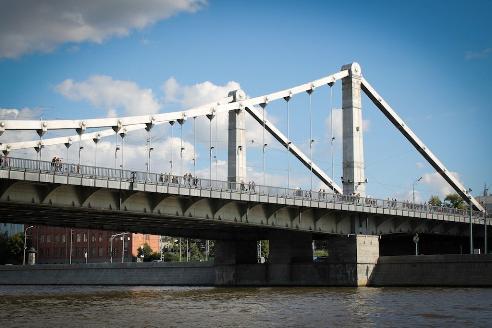One of the many attractions of the capital, of course, is the Crimean bridge connecting the two arches of the Garden Ring into a single transport communication. It is interesting both for its architectural solution, and for the many historical circumstances associated with it. Let us take a closer look at this important object of the capital's transport infrastructure.
From the history
The Moskva River in this place had a shallow depth, this provided the possibility of fording it. Crimean ford was named after the representative office of the Crimean Khanate located in Moscow located here. This place was the starting point of the trade routes connecting the capital of the Russian state with the southern territories. The current Crimean bridge is already the fourth in a row. The first bridge over the Moscow River appeared here at the end of the eighteenth century. It was wooden, and therefore short-lived. In 1870 it was replaced by a metal bridge, which was destined to stand here for more than half a century. The bridge was rebuilt several times, but by the beginning of the thirties it became clear that it was simply impossible to upgrade it in accordance with the requirements of transport traffic of the twentieth century.
An important element of the reconstruction plan of Moscow
Of course, in the first half of the twentieth century, radical restructuring was demanded not only by the Crimean bridge. Moscow could no longer live and develop with the transport infrastructure, which was formed almost in the Middle Ages. The so-called "Stalinist plan for the reconstruction of Moscow" was dedicated to bringing the capital into line with the requirements of our time. The new Crimean bridge, located almost in the center of the city, was one of the key objects ensuring the organization of a new rational traffic scheme. It envisaged the creation of a network of major transport routes providing unhindered communication between the central part of the capital and its peripheral areas. To implement this project, it was necessary to demolish and re-plan many quarters of the historical center of Moscow.
Architectural features of the new Crimean bridge
The main requirement for a bridge facility on the Garden Ring is to ensure the throughput of significant traffic flows in both directions. In addition, the bridge in the center of the Soviet capital was supposed to correspond to the status of the place in terms of architectural expressiveness. The new Crimean bridge, which came into operation on May 1, 1938, fully satisfied this entire set of requirements. In its engineering solution, this bridge facility for its time was largely unique. By the type of its construction it is a three-span suspension bridge with a total length of 688 meters. It provides both the passage of ships under the main span, and transport traffic under the side spans on sections of the embankment on both banks. The supporting structure of the structure is two separate supporting pylons with a height of 28 meters. A complex suspension system consisting of chain and cable metal structures gives the bridge special visual expressiveness. In its style, the Crimean bridge is one of the most striking works of constructivism. This architectural direction was one of the dominant ones not only in the Soviet Union in the pre-war period, but also in many European countries.

Bridge reconstruction
Common problems characteristic of traffic in Moscow at the beginning of the third millennium did not pass by the Crimean bridge. The bridge object was not designed for such an intensity of automobile traffic. All of his designs for several decades were operated in maximum load. These circumstances caused the general reconstruction of the Crimean bridge, carried out over several months of 2001. During this period, the cover of the carriageway and sidewalks was replaced, the waterproofing was replaced, cleaned from corrosion and a number of supporting and auxiliary metal structures were replaced. And also a lot of work was done to replace and restore the granite cladding of stairs and architectural elements on the approaches to the bridge. Reconstruction work was completed in a short time.
Crimean bridge. Pier in the city center
In the tourist infrastructure of the capital, this place is known as the starting point of water routes along the Moscow River. Pleasure boats depart from here in both directions. Recently, this type of recreation is becoming increasingly popular. In addition to walks and excursions on the open decks of motor ships, corporate entertainment events, weddings and anniversaries are often held. The starting point for such trips is ideally suited for its location in the city center, convenient access roads and a parking lot. It's easy to find it - Krymsky Most pier, address: Frunzenskaya embankment.